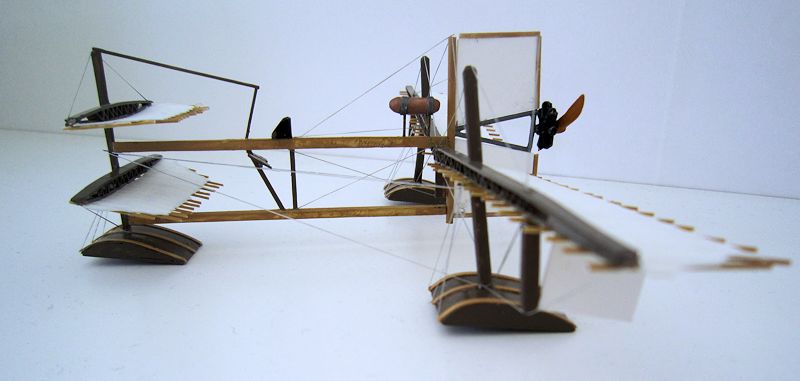
1/72 1910 Fabré Hydroplane
| KIT #: | |
| PRICE: | $ |
| DECALS: | None |
| REVIEWER: | Chris Peachment |
| NOTES: | Scratchbuilt from plastic card, rod and strut. |

| HISTORY |
The very first successful seaplane to take off from water under its own
power is credited to Henri Fabré
(1882-1984) in 1910. He was born into a prominent family of ship
owners in
Marseilles, and he had already patented a system of floatation devices, which he
used on his first aircraft. In spite of never having flown before, in March 1910
he completed four consecutive flights of about 500 yards.
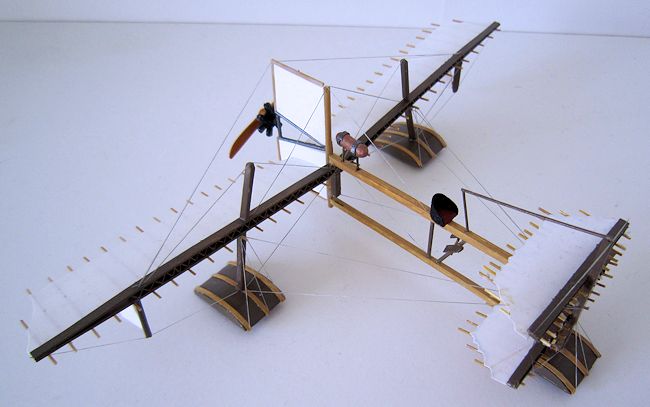 'There was an alarming incident at Monaco this morning... The machine
crossed the harbour in perfect style, skimming along the surface; nearing the
harbour mouth, it rose up into the air to a height of about 30 yards, and soared
along beautifully, greatly admired by thousands of spectators. As soon as it
cleared the harbour, however, and encountered the full force of the wind
outside, the machine became unmanageable and to the horror of the onlookers was
swept along at a terrific pace towards the rocks and stone walls below the
terraces. Fortunately, M. Fabré, with great presence of mind, managed to throw
himself clear of the machine into the sea, and was promptly picked up, none the
worse for his startling experience.'
'There was an alarming incident at Monaco this morning... The machine
crossed the harbour in perfect style, skimming along the surface; nearing the
harbour mouth, it rose up into the air to a height of about 30 yards, and soared
along beautifully, greatly admired by thousands of spectators. As soon as it
cleared the harbour, however, and encountered the full force of the wind
outside, the machine became unmanageable and to the horror of the onlookers was
swept along at a terrific pace towards the rocks and stone walls below the
terraces. Fortunately, M. Fabré, with great presence of mind, managed to throw
himself clear of the machine into the sea, and was promptly picked up, none the
worse for his startling experience.'
One can see the attractions to early pilots of using water-borne
machines. Hurling oneself to safety out of an aircraft above land would not have
ended so happily.
The
Fabré
aircraft was a canard monoplane, whose structure made
use of a beam designed by Fabré himself.
This is two girders joined by an internal system of
rectangular struts, known as a warren truss. Two of these beams, one above the
other and connected by three
struts, formed the fuselage of the aircraft, and as far
as can be seen from photos, were covered in fabric. The wing however used an
exposed beam for its leading edge, and sat with a pronounce dihedral, with a
Gnome rotary engine behind
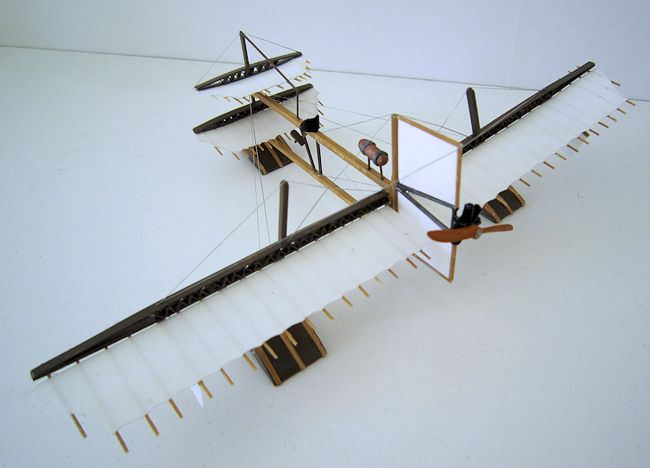 it. Bracing for the wings was by kingposts
at mid-span. The two foreplanes also had exposed Fabré
beams as their leading edges.
it. Bracing for the wings was by kingposts
at mid-span. The two foreplanes also had exposed Fabré
beams as their leading edges.
A rectangular rudder sat above the wing. Below the wing there was a
similar fixed surface extending down to the lower fuselage beam. The aircraft
had
three broad floats.
Following this record breaking flight, Henri Fabré settled for building
floats for other aviation pioneers. One can't help but wonder if his life-saving
dive into the sea hadn't given him a warning about defying gravity.
As late as 1971, the aged Fabré could still be seen sailing his own boat
single handedly in Marseilles harbour. He died in 1984 at the age of 101, one of
the last living pioneers of human flight. His hydroplane was later restored and
can be seen at the French Air and Space museum.
| CONSTRUCTION |
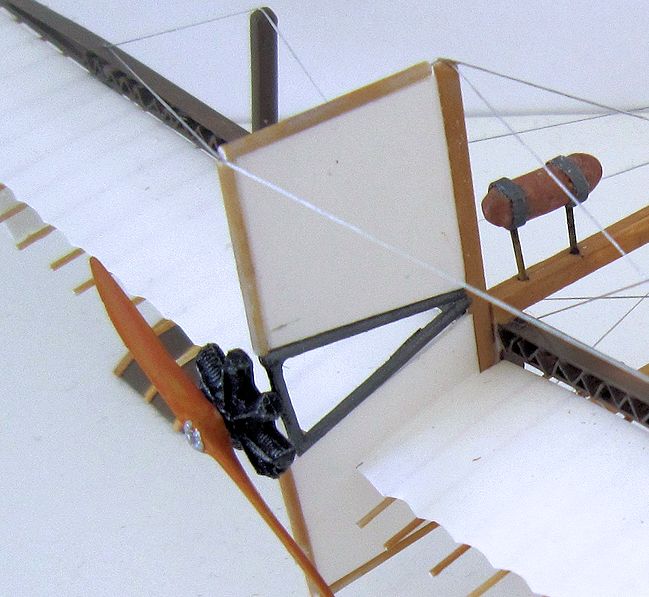 trickiest part of the whole operation. Those warren truss beams at the leading
edges of the wing and foreplanes. In fact it wasn't so difficult, just time
consuming, and a good test of one's patience. Lengths of plastic card were cut
for the main beams, and small rectangular pieces for the internal struts, which
were then stacked at 45 degree angles like the base of a house of cards. The
ends of the beams were joined to
form a bow-like configuration. At this point
one can admire the trusses for what they were. Even in this scale, they are very
strong and don't flex at all under pressure.
trickiest part of the whole operation. Those warren truss beams at the leading
edges of the wing and foreplanes. In fact it wasn't so difficult, just time
consuming, and a good test of one's patience. Lengths of plastic card were cut
for the main beams, and small rectangular pieces for the internal struts, which
were then stacked at 45 degree angles like the base of a house of cards. The
ends of the beams were joined to
form a bow-like configuration. At this point
one can admire the trusses for what they were. Even in this scale, they are very
strong and don't flex at all under pressure.
The
fuselage was simply a question of cutting off some rectangular beams from the
edge of thick 40 thou card.
The wings
were one surface of linen, which were sewn onto curved ribs. For this I cut out
some thin 10 thou card, marked where the ribs went, sprayed them white, then
spent some happy hours gluing down lengths of rod, which had already been
painted sandy brown.
It is hard to tell from contemporary pictures, but I
suspect the ribs were joined to the lower leading edge of the warren truss beam,
and were hinged with limited movement at that point to allow them to be formed
by the airflow, much as in a yacht.
I think
that M. Fabré
was on to something aerodynamically important
here without realising it. The beam
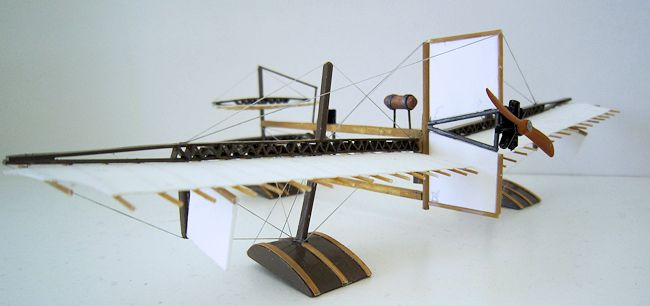 itself would have
channelled the air over the upper surface of the wing, in much the same fashion
as modern leading edge slats do, and thus created a high pressure area over the
upper surface which would have greatly helped with flight. The same with the
smaller foreplanes, which were constructed in similar fashion.
itself would have
channelled the air over the upper surface of the wing, in much the same fashion
as modern leading edge slats do, and thus created a high pressure area over the
upper surface which would have greatly helped with flight. The same with the
smaller foreplanes, which were constructed in similar fashion.
Floats
were made from card, painted dark brown, and some lighter brown straps were
added, like hoops around a barrel.
The kingposts for the wings were also made from edge
cuts from thick 40 thou plastic, sanded to shape and glued to the wing leading
edges. Note that they sit at very odd angles.
Once the
wings and foreplanes and floats were in place, it was all over bar the shouting.
A simple triangle of rod holds the engine and propeller (from the spares box) in
place. The fins were formed from 10 thou card surrounded by brown rod.
I did the
rigging at this point, since all but the fiddly bits were left. Elastic thread,
painted silver with a felt
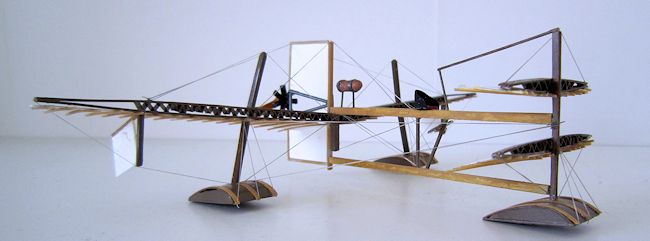 tip pen, and then superglued down, using the
principle that wherever a beam or a strut or a rod ends, then it will be rigged
to a nearby beam or strut end. The plans are very clear, as are many of the
photos, so follow these and you can't go wrong.
tip pen, and then superglued down, using the
principle that wherever a beam or a strut or a rod ends, then it will be rigged
to a nearby beam or strut end. The plans are very clear, as are many of the
photos, so follow these and you can't go wrong.
In fact it
is a good idea to keep a stack of the printed out photos near your elbow on the
workbench. Keep consulting them and you will find life much easier.
A seat
from the spares box went on top of the main fuselage beam. Some foot pedals were
added from 10 thou card. A fuel tank was sanded down from some thick sprue,
painted old copper, with a couple of gunmetal bands around it, and mounted on
two metal struts.
There are
no markings, since no one yet had invented them.
The paint used overall was Modelmaster for the shades of
brown, and Humbrol Primer White for the linen. It is best to paint as you go
along.
Weathering was kept to a minimum as pictures show the aircraft kept in a
clean state.
| CONCLUSIONS |
There
you have it. The very first aircraft to power itself off the water. And a fine
tribute to M. Fabré , who got up one morning never have flown in his life,
strapped himself to this collection of toothpicks and did four consecutive
flights across the bay. You have to admire the courage of those pioneers. Ask
yourself this: would you do it?
| REFERENCES |
Apart from
the one in the French museum, I see that a group of enthusiast have made a
replica of the Fabré and look to be flying it successfully off a river.
Wonderful though it is, be warned about using their replica for a reference. It
very sensibly has updated various parts of the design to make it safer.
http://www.forum-conquete-spatiale.fr/t10234-28-mars-1910-premier-vol-en-hydravion
http://www.ctie.monash.edu.au/hargrave/fabre.html
http://flyingmachines.ru/Site2/Crafts/Craft28474.htm
http://wp.scn.ru/en/ww1/h/1877/21_o/0
April 2015
If you would like your product reviewed fairly and fairly quickly, please contact the editor or see other details in the Note to Contributors.